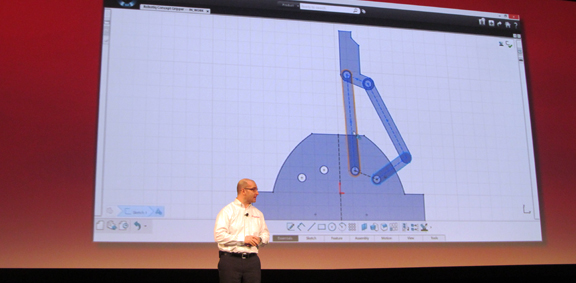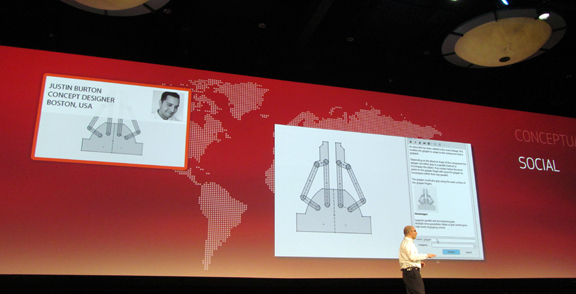Latest News
January 21, 2013
Conceptual, social, instinctive, and connected—That’s how Fielder Hiss, SolidWorks’ VP of product development, summed up the new product SolidWorks Mechanical Conceptual. The presentation was part of Monday’s opening keynote session at the annual SolidWorks user conference, SolidWorks World 2013.
“This is what you’ve told us: 31% of all project times is spent on concepts. That’s a lot of time,” said Hiss. “On average, there are six iterations in that conceptual phase. 3 out of 4 engineers are engaged in that process.”
These and other findings about the company’s core customers, Hiss suggested, were the reasons behind the development of Mechanical Conceptual, a new product based on parent company Dassault Systemes’ 3DExperience philosophy.
The demonstration revealed a software program with 2D sketching, 3D geometry building, and simple dynamic simulation functions. The underlying modeling engine can facilitate direct, history, and parametric modelings in a single environment, Hiss explained.
Because the conceptual phase in modern product development revolves around “social innovation,” the new product will incorporates social media-like collaboration features, he explained. “What we’re doing is removing the noise in social media and letting all the benefits of it to be applied to engineering,” he said.
Multiple concept management, mobile apps, and tablet support round out the feature set in Mechanical Conceptual.
The Underserved Market
Mechanical CAD software developers have long courted the conceptual design segment, but the legacy of CAD, rooted in detailed production drawings and manufacturing-grade geometry, prevented market leading programs from effectively addressing the early product development phase. It left an opening for consumer-friendly Google SketchUp, newcomer SpaceClaim, and a few others to capture a portion of the market.
In the last four or five years, leading CAD developers like Autodesk, PTC, and Siemens PLM Software began to pursue the conceptual phase with renewed vigor, using direct-editing programs that are easier to learn and use than typical parametric CAD software. Thus, Autodesk Inventor Fusion, PTC Creo/Direct, Solid Edge with Synchronous Technology, and others emerged. Now SolidWorks joined the battle with Mechanical Conceptual.
Courting New Markets
Some leading MCAD makers like Autodesk has begun courting the prosumer and consumer markets with easier versions of their software. The hobbyists, tinkerers, and maker communities represent new fields, tantalizingly close to the professional 3D modeling market served by CAD. SolidWorks Mechanical Conceptual, however, is strictly aimed at the professional design and engineering market—at least, for now.
“Step one is for us to target the professional market [with Mechanical Conceptual],” said Bertrand Sicot, SolidWorks CEO, in his meeting with DE editors at the conference. “I’m convinced there’s room for 3D for prosumer market. But for this first application, we’re not thinking about that.”
Thick Local Client, Augmented by Cloud-Hosted Data
Internally, SolidWorks R&D staff debated over the right architecture for the new software. In the end, they settled on a thick client (a hefty program that runs on your desktop or laptop), connected to cloud-hosted data center.
“When I say ‘Connected,’ I don’t say ‘Cloud,’ ” Sicot clarified. He was well aware that SolidWorks’ rival Autodesk, by contrast, is betting heavily on the cloud. (For more, read “Autodesk Rounds Out 360 Portfolio With Cloud-Based CAD” by Beth Stackpole, Nov 28, 2012.)
Assurance for SolidWorks Users
In the past, the mention of new products stirred controversies among some loyal fans of SolidWorks, who worried that the company might lose focus or change their beloved software beyond recognition. (Read “SolidWorks: Exploring Mac, But Not Timetable for Delivery,” Kenneth Wong, February 2010.) To prevent a similar outburst online, Sicot issued an assurance from the main stage during his keynote:
“[Development of] SolidWorks Mechanical Conceptual will not be at the expense of—I shall repeat—will not be at the expense of SolidWorks,” he said with emphasis.
Sales, Pricing, and Testing
The company plans to distribute the new product through the reseller channel. It hasn’t set the price for Mechanical Conceptual, but Sicot gave a clear indication. “It’s going to be within the range of SolidWorks,” he said. So don’t expect a dramatically lower price than SolidWorks’ typical $4,000 to $6,000 range.
In May, SolidWorks plans to enlist a number of volunteer customers to help test the software—not in simulated Beta environment but in real production environment. Sicot believes that’s the only way to correctly judge Mechanical Conceptual’s market readiness.
Subscribe to our FREE magazine, FREE email newsletters or both!
Latest News
About the Author
Kenneth Wong is Digital Engineering’s resident blogger and senior editor. Email him at [email protected] or share your thoughts on this article at digitaleng.news/facebook.
Follow DE








